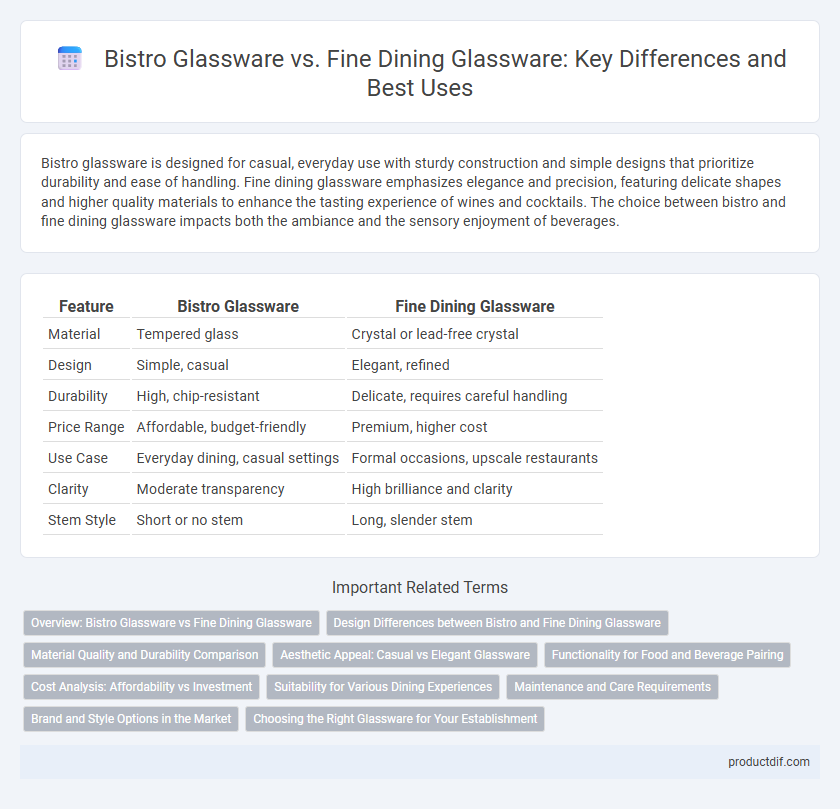Bistro glassware is designed for casual, everyday use with sturdy construction and simple designs that prioritize durability and ease of handling. Fine dining glassware emphasizes elegance and precision, featuring delicate shapes and higher quality materials to enhance the tasting experience of wines and cocktails. The choice between bistro and fine dining glassware impacts both the ambiance and the sensory enjoyment of beverages.
Table of Comparison
| Feature | Bistro Glassware | Fine Dining Glassware |
|---|---|---|
| Material | Tempered glass | Crystal or lead-free crystal |
| Design | Simple, casual | Elegant, refined |
| Durability | High, chip-resistant | Delicate, requires careful handling |
| Price Range | Affordable, budget-friendly | Premium, higher cost |
| Use Case | Everyday dining, casual settings | Formal occasions, upscale restaurants |
| Clarity | Moderate transparency | High brilliance and clarity |
| Stem Style | Short or no stem | Long, slender stem |
Overview: Bistro Glassware vs Fine Dining Glassware
Bistro glassware typically features durable materials with simple, functional designs suited for casual dining environments, prioritizing ease of use and affordability. Fine dining glassware, crafted from high-quality crystal or hand-blown glass, emphasizes elegance and precision to enhance the sensory experience of wine, champagne, and cocktails. The key differences lie in durability, design complexity, and purpose, with fine dining glassware tailored to elevate presentation and flavor nuances.
Design Differences between Bistro and Fine Dining Glassware
Bistro glassware features sturdy, practical designs with thicker rims and simpler shapes to withstand frequent use and casual settings. Fine dining glassware emphasizes delicate craftsmanship with slender stems, thin rims, and intricate contours to enhance the tasting experience and aesthetic appeal. The design differences reflect the functional needs and ambiance of bistro versus fine dining environments.
Material Quality and Durability Comparison
Bistro glassware typically features tempered glass or standard soda-lime glass, offering moderate durability suitable for casual dining with higher resistance to chipping and breakage. Fine dining glassware often utilizes high-quality crystal or lead-free crystal, prized for its clarity, elegance, and thinner rims, but requires more careful handling due to its fragile nature. The choice between bistro and fine dining glassware balances material strength and visual sophistication, with bistro glassware prioritizing durability and fine dining emphasizing material excellence and aesthetic appeal.
Aesthetic Appeal: Casual vs Elegant Glassware
Bistro glassware features a casual, sturdy design with simple lines and durable materials that enhance everyday dining experiences, making it ideal for relaxed environments. Fine dining glassware showcases elegant, delicate craftsmanship with intricate details and refined shapes that elevate the aesthetic appeal of upscale dining settings. The difference in aesthetic appeal lies in the balance between functionality and sophistication, where bistro glassware emphasizes practicality and fine dining glassware emphasizes visual luxury.
Functionality for Food and Beverage Pairing
Bistro glassware is designed for versatility and durability, making it ideal for casual settings where a wide range of beverages and food pairings are served efficiently. Fine dining glassware prioritizes precise shapes and sizes that enhance the aroma and flavor profiles of specific wines and spirits, elevating the sensory experience during sophisticated meals. The functional design differences directly impact the effectiveness of food and beverage pairing, with fine dining glassware supporting nuanced appreciation and bistro glassware enabling practical, multi-use performance.
Cost Analysis: Affordability vs Investment
Bistro glassware typically offers a cost-effective option with durable materials designed for frequent use, making it ideal for casual dining environments focused on affordability. Fine dining glassware represents a higher investment, featuring premium crystal and intricate designs that enhance aesthetic appeal and elevate customer experience. The cost analysis reveals bistro glassware prioritizes long-term savings through replaceability, while fine dining glassware emphasizes value through quality and exclusivity.
Suitability for Various Dining Experiences
Bistro glassware features durable designs and moderate elegance, making it ideal for casual dining and fast-paced environments where functionality is key. Fine dining glassware offers intricate craftsmanship and delicate materials suited for upscale restaurants, enhancing the sensory experience of gourmet meals and wine pairings. Choosing the right type depends on the desired ambiance and service style, with bistro glassware favoring practicality and fine dining glassware emphasizing sophistication.
Maintenance and Care Requirements
Bistro glassware typically features sturdy designs that withstand frequent handling and dishwasher cycles, making maintenance simple and cost-effective for high-traffic environments. Fine dining glassware, often made from delicate crystal or thin glass, requires careful hand washing and specialized storage to prevent chips and maintain clarity. Proper care of fine dining glassware preserves its aesthetic appeal and enhances the overall dining experience by ensuring impeccable presentation and longevity.
Brand and Style Options in the Market
Bistro glassware brands like Libbey and Pasabahce offer durable, versatile styles designed for casual dining and high turnover environments, emphasizing affordability and functionality. Fine dining glassware from brands such as Riedel and Waterford showcases elegant designs with sophisticated craftsmanship, catering to upscale restaurants seeking to enhance the dining experience. The market features a broad range of options where bistro glassware prioritizes resilience and ease of use, while fine dining collections highlight aesthetic refinement and premium materials.
Choosing the Right Glassware for Your Establishment
Bistro glassware offers durability and practicality, designed for high-volume use in casual dining settings, while fine dining glassware emphasizes elegance and enhances the sensory experience of premium beverages. Choosing the right glassware involves assessing factors such as the restaurant's ambiance, clientele expectations, and beverage offerings to ensure functionality aligns with presentation. Investing in quality materials like crystal for fine dining or tempered glass for bistros improves longevity and customer satisfaction.
Bistro Glassware vs Fine Dining Glassware Infographic

 productdif.com
productdif.com